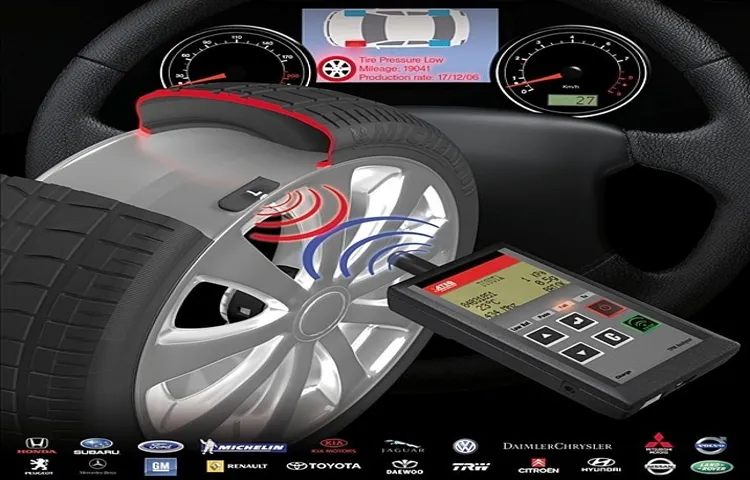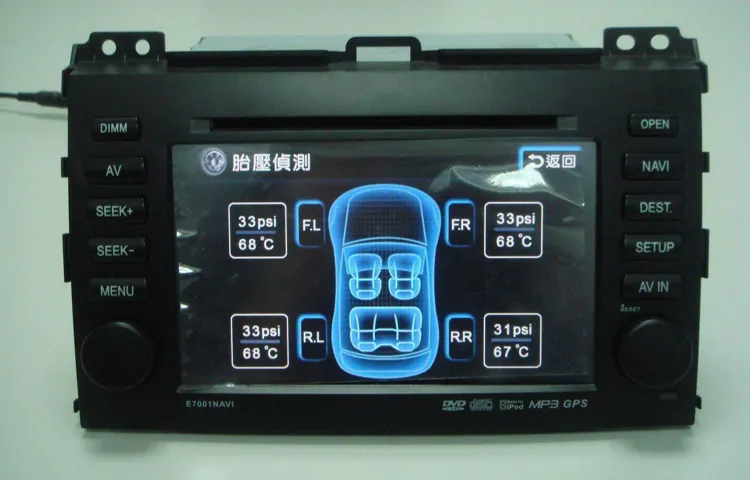Do you know how to check your car’s tire pressure monitoring system? Keeping track of tire pressure is an essential maintenance task for any driver. Unfortunately, too many car owners neglect this simple but crucial step, which can lead to potential safety hazards and decreased fuel efficiency. In this blog post, we’ll walk you through the steps to check your tire pressure monitoring system and ensure your tires are at the correct pressure.
From understanding the various types of tire pressure monitoring systems to using a tire pressure gauge, we’ve got you covered. So, let’s dive in and learn how to keep your tires in top shape!
Table of Contents
Introduction
Checking your tire pressure monitoring system is an essential part of maintaining your vehicle’s safety and performance. The first step in this process is to locate the tire pressure monitoring system sensor, which is typically located inside each tire’s valve stem. You can easily check the tire pressure sensors by using a handheld tool or by visiting a mechanic.
The handheld tool is a simple and quick way to check the tire pressure sensors yourself. Insert it into your tire’s valve stem and wait for it to provide an accurate reading. Alternatively, you can visit your mechanic who can run a diagnostic test to check the sensors and identify any issues that may need fixing.
Properly maintaining your tire pressure monitoring system ensures you get the best performance from your vehicle and keeps you safe on the road. So, make sure you check your tire pressure monitoring system regularly, and stay on top of its maintenance.
Explanation of tire pressure monitoring systems
Tire pressure monitoring systems have become a standard feature in modern vehicles. These systems monitor the air pressure within a vehicle’s tires and alert the driver if the pressure falls below a certain threshold. This is an important safety feature as driving on underinflated tires can lead to decreased fuel efficiency, reduced tire lifespan, and potentially even a blowout.
With a tire pressure monitoring system, the driver is warned before any damage occurs, allowing them to take action and prevent a dangerous situation. The technology behind these systems works by using sensors mounted on each tire that communicate with the car’s computer. The computer then processes this data and alerts the driver via a warning light on the dashboard.
Overall, tire pressure monitoring systems are a simple but crucial safety feature in modern vehicles that help to prevent accidents and promote safe driving.

Why it’s important to check tire pressure
Tire pressure might seem like a small detail, but it can make a big impact on your overall safety while driving. Neglecting to check your tire pressure regularly can cause a range of issues, including decreased fuel efficiency, uneven wear and tear on your tires, and even dangerous blowouts. Plus, properly inflated tires can improve your car’s handling and help you avoid accidents in emergency situations.
That’s why it’s crucial to make sure your tire pressure is at its optimal level before hitting the road. By taking a few minutes to check your tire pressure and make any necessary adjustments, you can stay safe on the road and avoid costly emergencies. So next time you’re getting ready to drive, remember to check your tire pressure first!
How to Check Tire Pressure Monitoring System
Checking your tire pressure monitoring system is an essential part of ensuring your vehicle’s safety. Not only does it help you maintain optimal performance, but it also lets you know if a tire is underinflated or punctured, preventing potential accidents and tire blowouts. To check your tire pressure monitoring system, you will need to locate the TPMS button on your dashboard, which looks like an exclamation point inside a tire shape.
Press and hold it until you see the light blink for a few seconds before turning off. Then, check your tire pressure manually using a tire gauge, comparing it with the recommended pressure for your vehicle in the owner’s manual. If any of the tires read below the recommended level, refill it with air and check again.
Repeat this process until all of your tires are properly inflated, and the tire pressure monitoring system light turns off. Regularly checking your TPMS is an important part of keeping your vehicle in top condition, so make sure to mark your calendar for regular check-ups.
Step-by-step process for checking tire pressure
Checking tire pressure is an essential car maintenance task that every driver should do regularly. One of the ways to check tire pressure is with a tire pressure monitoring system (TPMS). First, you need to turn on your car and ensure the tire pressure monitoring system is active.
Then, use a tire pressure gauge to check the air pressure of each tire. Remove the nozzle cap, attach the gauge, and press down on the gauge until the hissing sound stops. The gauge will show you the pressure reading.
Compare the pressure reading with the manufacturer’s recommended pressure in your car owner’s manual or on the driver’s side door jamb. If your tires need more air, add it using an air compressor at your local gas station. Once the pressure is correct, replace the nozzle cap.
Lastly, reset the tire pressure monitoring system to ensure it registers the new pressure. Overall, checking your tire pressure with a TPMS is relatively straightforward, and it can help keep you safe on the road.
Tools needed for checking tire pressure
When it comes to checking tire pressure, it’s important to have the right tools on hand. A tire pressure gauge is a must-have, as this tool ensures your tire’s air pressure is at the correct level. Most car manufacturers recommend checking your tires at least once a month, and before a long road trip.
You can also invest in a Tire Pressure Monitoring System (TPMS), which alerts you when your tire pressure is low. This technology uses sensors in your tires to monitor air pressure and sends alerts to your dashboard when there’s a problem. Checking your tire pressure regularly will not only save you money on fuel, but it will also decrease your risk of a tire blowout or a flat tire on the road.
Don’t forget about the spare tire, as it’s just as important to check and maintain its pressure as well. By using these tools to check and maintain your tire pressure, you’ll ensure your safety and enjoy a smoother ride.
Tips for accurate tire pressure readings
Tire pressure monitoring system Have you ever wondered why maintaining the correct tire pressure is important for safe driving? The answer lies in the tire pressure monitoring system (TPMS). The TPMS is a safety feature that alerts you when the tire pressure is low or high. To check the tire pressure, first, make sure the tires are cool and not hot from driving.
Then, locate the manufacturer’s recommended PSI (pounds per square inch) values for your vehicle which can be found in the owner’s manual or the driver’s side door jamb. Next, use a tire pressure gauge to measure the pressure in each tire. If the pressure is too low, add air until it reaches the recommended PSI.
If it’s too high, release some air until it’s at the recommended level. Remember to check your tire pressure regularly to ensure optimal performance and safety on the road. By following these tips for accurate tire pressure readings, you can rest easy knowing that your TPMS is functioning properly and keeping you safe on the road.
Troubleshooting Issues with Tire Pressure Monitoring System
If you’re having issues with your tire pressure monitoring system (TPMS), there are a few things you can do to troubleshoot the problem. First, check the pressure in your tires with a reliable tire pressure gauge. Make sure the tire pressure matches the recommended pressure listed in your vehicle’s owner’s manual or on the driver’s side door jamb.
If the pressure is correct, but the TPMS warning light is still on, it could be a sensor issue. You can test the sensors using a TPMS diagnostic tool or bring your vehicle to a mechanic for a professional diagnosis. It’s essential to address any TPMS problems promptly because an inaccurate reading can lead to unsafe driving conditions and potentially cause a blowout.
By regularly checking your tire pressure and addressing any TPMS issues promptly, you can ensure your safety on the road.
Common issues with tire pressure monitoring systems and how to troubleshoot them
If you find that your tire pressure monitoring system is giving you problems, you’re not alone. Many drivers experience issues with these systems, such as false alerts or failure to accurately display tire pressure levels. When troubleshooting, the first step is to check your tire pressure manually with a gauge – this can help you identify if the issue lies with the sensor or the tire itself.
If the sensor is not functioning properly, you may need to have it replaced. Another common issue is interference from electronic devices, which can disrupt the system’s communication with the sensors. If this is the case, try moving the device or turning it off to see if the alerts disappear.
Keeping your sensors clean and free from debris can also help to prevent false alerts. By understanding the common issues with tire pressure monitoring systems and how to troubleshoot them, you can stay safe on the road and ensure your tires are in good condition.
When to seek professional help for tire pressure monitoring system issues
If you are experiencing issues with your tire pressure monitoring system, it can be difficult to determine when to seek professional help. While some issues can be easily resolved with a quick check of the tires or resetting the system, other problems may require the expertise of a trained mechanic. If you notice your tire pressure warning light constantly illuminating, even after adding air to the tires, it may be time to seek professional help.
Additionally, if you are experiencing intermittent or inconsistent alerts from your system, it’s best to have it checked out to ensure that there is not a malfunction in the system. Overall, it’s important to remember that the tire pressure monitoring system is a crucial component in keeping you safe on the road, and any issues should be addressed promptly to avoid potential safety hazards.
Conclusion
In summary, checking your tire pressure monitoring system is crucial to ensure safe and efficient travels. Simply follow these easy steps: locate the TPMS button, press and hold until you hear a beep, inspect each tire for the appropriate pressure, and adjust accordingly. Remember, a well-maintained set of tires not only saves you money in the long run but also keeps you and your passengers safe on the road.
So, don’t be caught with flat tires or low pressure, keep an eye on your TPMS. Happy and safe travels!”
Importance of regularly checking tire pressure monitoring systems
Regularly checking your tire pressure monitoring system is of paramount importance for ensuring safety on the road. There are several issues that may arise with your TPMS that you should troubleshoot as soon as possible. One of the most common problems is a faulty sensor.
Over time, sensors can become damaged or fail, leading to inaccurate readings. Other common issues include low battery voltage, wiring problems, or even a blown fuse. It’s important to address any of these problems quickly to avoid potential safety hazards.
To check for issues, use a tire pressure gauge to manually check the pressure in each tire and compare it to the readings on your TPMS. If there is a discrepancy, it’s time to get your TPMS checked out. By staying on top of your TPMS, you’ll ensure that your tires are properly inflated and your vehicle is operating safely on the road.
Final thoughts on maintaining safe tire pressure
Maintaining safe tire pressure is crucial to ensure optimal performance and safety while driving. However, issues with the Tire Pressure Monitoring System (TPMS) can arise, making it challenging to monitor and maintain proper tire pressure levels. One common issue with the TPMS is when the warning light comes on even though the tires are properly inflated.
This may be due to damage to the TPMS sensors or a software glitch. Another issue is when the warning light doesn’t come on even though the tire pressure is too low. This may be caused by a faulty sensor or a low battery.
In both cases, it’s best to bring your vehicle to a trusted mechanic to diagnose and resolve the issue. Remember, proper tire pressure is crucial for your safety and the longevity of your tires. So, don’t neglect the importance of keeping your TPMS in excellent working condition.
FAQs
What is a tire pressure monitoring system (TPMS)?
A TPMS is a system that monitors the air pressure in your vehicle’s tires and alerts you when it’s low.
How do I know if my vehicle has a TPMS?
Most vehicles manufactured after the year 2008 have a TPMS. You can also check your owner’s manual or contact your dealership to find out.
How often should I check the tire pressure in my vehicle with a TPMS?
It’s recommended that you check your tire pressure at least once a month, but your vehicle’s TPMS may also alert you when the pressure is low.
Can a TPMS sensor be replaced or repaired?
Yes, a TPMS sensor can be replaced or repaired by a qualified technician.
What happens if I ignore a TPMS alert?
Ignoring a TPMS alert can lead to decreased fuel efficiency, decreased tire life, and even tire damage or blowouts.
Can weather affect TPMS readings?
Yes, extreme hot or cold temperatures can affect TPMS readings, so it’s important to check your tire pressure regularly.
Is it safe to drive with a TPMS alert on?
It’s not recommended to drive with a TPMS alert on, as it can lead to tire damage or blowouts. It’s important to address the issue as soon as possible.



